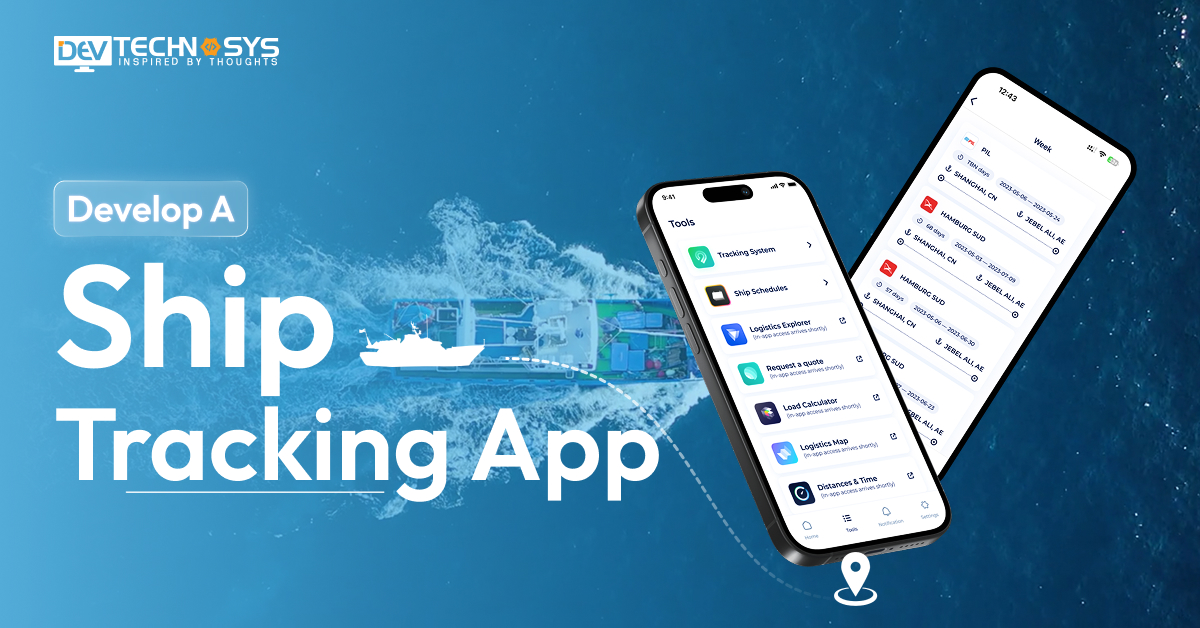“Port-to-Port Insights”
In today’s fast-paced maritime world, the demand for real-time ship tracking applications has surged across industries like logistics, shipping, defense, and tourism. A ship tracking app enables users to monitor vessel locations, routes, and maritime conditions with pinpoint accuracy.
According to the global market, the vessel tracking application market is valued at around $5.74 billion in 2024, and it is expected to increase to around $10.06 billion by the end of 2034.
The above data reveals that investing in the ship tracking app development is a lucrative opportunity to expand the business to new levels.
Let’s start with how to build a ship tracking app with advanced features, know about the development cost, and much more related information.
What is the Ship Tracking App?
A Ship Tracking App is a digital system that enables users to track the real-time position, route, and condition of boats in international seas. It uses GPS, AIS data, and maritime traffic APIs to give real-time tracking, ship information, and route history. The app, designed for logistics, marine operations, and hobbyists, improves navigation, safety, and fleet management by providing precise, on-demand information.
- Real-Time Ship Tracking
- Interactive Marine Maps
- Route History
Market Analysis of Global Ship Tracking Applications
- The market for ship monitoring applications is projected to grow from its 2024 valuation of $5.74 billion to $10.06 billion by the end of 2034.
- As per the recent study, the vessel tracking application market is increasing with a compound annual growth rate of 77% from 2025 to 2034.
- With a market value of 3 USD billion, North America is the region with the greatest market share in the vessel tracking system market in 2023.
- Among the leading companies in the vessel tracking system market are Spire Global, Acensblue, Verifli, and Wärtsilä.
- The market is anticipated to expand significantly in the APAC region, reaching a projected value of4 USD billion by 2032.
10 Best Ship Tracking Applications
Discover the ten most effective vessel tracking apps that provide real-time vessel monitoring, detailed marine data, and seamless navigation features, ideal for maritime professionals, logistics companies, and ocean enthusiasts.
![]()
| Applications | Download Users | Stores Ratings | Apps Launched On | Platform Accessibility |
| MarineTraffic | 10M+ | 4.8 | 2007 | iOS, Android, Web |
| ShipAtlas | 500K+ | 4.2 | 2020 | Android/iOS |
| AfterShip Package Tracker | 5M+ | 4.7 | 2011 | Android/iOS |
| 17TRACK Package Tracker | 10M+ | 4.2 | 2013 | Android/iOS |
| Route: Package Tracker | 1M+ | 4.6 | 2018 | Android/iOS |
| Deliveries Package Tracker | 1M+ | 4.2 | 2010 | Android/iOS |
| ParcelTrack | 1M+ | 3.3 | 2016 | Android/iOS |
| Shop | 10M+ | 4.7 | 2017 | Android/iOS |
| OneTracker | 100K+ | 4.2 | 2019 | Android/iOS |
| Ship Info | 100K+ | 4.7 | 2017 | iOS |
Why Businesses Invest in Ship Tracking App Development?
In the age of global trade and real-time logistics, many organizations have prioritized freight management system software development. Here are five major reasons why businesses engage in developing these specialized applications:
- Real-Time Fleet Visibility
- Operational Efficiency and Cost Reduction
- Improved Security and Risk Management
- Regulatory Compliance and Documentation
- Data-Driven Decision-Making
![]()
1. Real-Time Fleet Visibility
Ship monitoring applications give live position data, allowing businesses to watch boats across the world in real time. This openness enables logistics managers to predict delays, reroute goods, and offer clients precise estimated arrival times. The ability to track fleet movements enables firms to improve customer service and operational efficiency.
2. Operational Efficiency and Cost Reduction
If you build marine fleet management software, it allows businesses to optimize routes, eliminate idle time, and avoid unlawful pauses. These changes result in decreased fuel usage and maintenance expenses. Furthermore, automatic data collection reduces human error and the requirement for manual reporting, hence increasing productivity.
3. Improved Security and Risk Management
Shipping companies confront several hazards, ranging from piracy to extreme weather conditions. Ship monitoring programs frequently include alerts for bad circumstances, unlawful route diversions, and entry into high-risk zones. These security features enable businesses to take proactive steps to reduce possible dangers to cargo and workers.
4. Regulatory Compliance and Documentation
Modern marine activities must adhere to strict international regulations (e.g., SOLAS and IMO). If entrepreneurs build a logistics management software, it may automate compliance by recording journey data, timestamps, and location histories, resulting in a digital audit trail. This makes regulatory reporting simpler and more dependable.
5. Data-Driven Decision-Making
Ship monitoring applications collect a large amount of data, including routes, speeds, delays, port activities, and fuel use. Businesses use this data to make educated decisions regarding scheduling, personnel, and investment. Predictive analytics can improve long-term strategic planning and competitiveness.
How AI Can Improve Ship Tracking Applications?
- AI analyzes sensor data to predict equipment failures, reducing downtime and maintenance costs through proactive service scheduling.
- AI suggests fuel-efficient, time-saving routes by analyzing weather patterns, ocean currents, and port congestion in real time.
- AI detects unusual vessel behavior or route deviations to alert operators about possible threats like piracy or unauthorized access.
- AI improves the estimated time of arrival by continuously learning from historical voyage data, live traffic, and port operations.
- AI tracks emissions and fuel usage, recommending operational changes to reduce the carbon footprint of shipping activities.
7 Key Steps to Build a Ship Tracking App
Building a marine tracking app requires a strategic approach, combining real-time GPS technology, intuitive design, and marine data integration. From planning and design to iOS or Android app development and launch, each step plays a critical role in delivering a seamless user experience. Here’s a step-by-step guide to help you get started.
- Define App Objectives
- Conduct Market Research
- Choose Technology Stack
- Design Intuitive UI/UX
- Develop Core Features
- Test and Optimize
- Launch and Maintain
![]()
1. Define App Objectives
Start by identifying your target users and core features. Decide whether the app will track commercial ships, personal boats, or global fleets. Hire dedicated developers to clarify your goals, such as real-time tracking, weather overlays, alerts, or analytics, to shape the project’s scope and technical requirements.
| Who is your target audience? |
| Should it support fleet management? |
| Is offline functionality required? |
2. Conduct Market Research
Analyze competitors, user pain points, and current market trends. Study popular ship tracking platforms to understand what works. Gather insights on pricing models, user expectations, and potential improvements to ensure your app stands out with a unique value proposition.
| Who are your main competitors? |
| What gaps exist in current solutions? |
| What trends are shaping ship tracking? |
3. Choose Technology Stack
In the third ship tracking mobile app development process, select the right technologies for the frontend, backend, and real-time GPS tracking. Use tools like AIS (Automatic Identification System), MarineTraffic APIs, and geolocation services. Ensure the stack supports scalability, security, and cross-platform deployment for Android, iOS, and web.
| Will the app be cross-platform? |
| What backend framework will you use? |
| What mapping API will you integrate? |
4. Design Intuitive UI/UX
Create user-friendly and accessible designs that prioritize clarity and ease of use. Use nautical themes, real-time map interfaces, and interactive elements. Include filters for ship type, route details, and weather data to deliver a seamless tracking experience.
| Are colors and fonts accessible? |
| Are the maps clear and responsive? |
| Is the design mobile-friendly? |
5. Develop Core Features
Move to the fifth stage, mobile app developers for hire to build essential functionalities such as live ship location, route history, port information, vessel details, and push notifications. Integrate APIs for marine traffic data and weather. Focus on performance and ensure smooth operation even with high user loads.
| What are the must-have features? |
| How will ships be tracked live? |
| Will the app support multiple languages? |
6. Test and Optimize
Conduct rigorous testing to ensure accuracy and app stability. Perform unit, integration, and usability tests across various devices. Gather beta feedback and fine-tune features to enhance real-time tracking, map responsiveness, and overall user satisfaction.
| Does the app run smoothly? |
| Is ship data updating in real time? |
| How will you measure performance improvements? |
7. Launch and Maintain
Come to the last stage of development, Android app developers for hire to deploy your app on chosen platforms and monitor its performance. Use analytics tools to track user behavior and app health. Provide regular updates, bug fixes, and new features. Offer responsive support to retain users and grow your maritime app’s reach.
| Have you submitted to the app stores? |
| What analytics tools will you use? |
| What’s your update schedule? |
10 Must-Have Premium Features of Ship Tracking Applications
To stay competitive and efficient in the maritime industry, fleet tracking solutions must offer advanced features that go beyond basic vessel monitoring. Here are ten must-have premium features every top-tier ship monitoring system should include:
![]()
1. Real-Time AIS Tracking
Advanced Automatic Identification System (AIS) tracking offers real-time vessel position, speed, direction, and voyage status to provide accurate situational awareness.
2. Historic Voyage Playback
This tool enables users to examine and evaluate previous travels, which aids in audits, performance assessments, and incident investigations.
3. Geofencing and Zone Alerts
Custom geofencing sends fast warnings when a vessel enters or departs certain zones, improving security and compliance monitoring.
4. Predictive ETA and Delay Forecasting
Using AI and historical data, the system estimates projected arrival times and probable delays to improve planning and consumer updates.
5. Weather and Ocean Conditions Overlay
Real-time integration of weather, wave, and wind data enables operators to select safer and more efficient routes.
6. Port Congestion Insights
Access to real-time port congestion and berth availability improves scheduling, minimizes idle time, and helps with turnaround planning.
7. Fleet Performance Analysis
Dashboards and reports monitor crucial data like as fuel consumption, engine condition, and operational efficiency across several boats.
8. Compliance and Emission Reporting
Automated logging and reporting of environmental and regulatory data ensures compliance with IMO, SOLAS, and MARPOL requirements.
9. Satellite Tracking Integration
Beyond coastal AIS, satellite tracking allows for worldwide vessel surveillance, even in distant or open-ocean zones.
10. Multi-User and Role-Based Access
Allow diverse stakeholders (such as operators, clients, and regulators) to have secure access with customizable views and control levels.
What is the Cost to Build a Ship Tracking App?
The cost to develop a ship tracking app ranges from $8,000 to $25,000, depending on its features, complexity, and platform (Web, iOS, or Android).
While a feature-rich app with AI-based ETA, weather integration, and analytics might cost over $25,000, a simple version with real-time AIS tracking and vessel search may cost between $8,000 and $15,000.
The tech stack, design specifications, and development location all affect costs. The overall budget should include account for ongoing costs for maintenance, data subscriptions (such as satellite AIS), and server hosting.
Cost to Build a Ship Tracking App
| Ship Tracking App Development
|
Estimated Cost | Time Frame |
| Basic App Development
|
$8000 – $12000 | 2 to 4 Months |
| Mid-Premium App Development
|
$14000 – $19000 | 5 to 8 Months |
| High-Premium App Development
|
$25000+ | 9+ Months |
5 Major Factors That Affect the Ship Tracking App Development Cost
The cost of developing a marine navigation app depends on features, app complexity, platform choice, design quality, development team location, third-party data integration (like AIS or weather APIs), and post-launch support. Advanced AI capabilities, satellite tracking, and compliance features can significantly increase the overall ship tracking app development cost.
![]()
1. Development Team
The cost varies significantly depending on the development team’s location, size, and competence. Hiring developers from North America or Europe costs more than outsourcing to Asia.
Pricing is also affected by whether you use freelancers, in-house developers, or an agency. A talented team offers faster delivery, higher code quality, and continuing technical support after launch.
| Developers Experience level | United States | United Kingdom | Southeast Asia | Eastern Europe |
| Junior-level | $15 – $25 | £14 – £24 | $12 – $22 | $10 – $20 |
| Mid-level | $30 – $50 | £27 – £44 | $25 – $35 | $25 – $33 |
| Senior-level | $60 – $80 | £50 – £65 | $40 – $55 | $40 – $50 |
2. Application Design
A well-crafted UI/UX design improves user experience but increases the cost of courier delivery app development. Designers must be proficient in order to create custom visuals, animations, intuitive layouts, and responsive design across several devices.
Investing in excellent design increases usability and user retention, making it a crucial cost-driver in developing a competitive and engaging ship monitoring program.
| Design Quality | Cost Estimation |
| Basic Design | $8,000 – $12,000 |
| Complex Design | $15,000 – $22,000 |
3. Support and Maintenance
Post-launch support includes bug repairs, upgrades, server monitoring, and the addition of new features. These continuing services are critical to app performance and security.
Regular maintenance assures compliance with changing legislation and operating systems. The cost is often determined as a monthly or annual charge, which should be included in the original budget.
| Service Level | Description | Estimated Annual Cost (USD) | Estimated Time |
| Basic Support | Bug fixes, minor updates | $3,000 – $6,000 | Ongoing |
| Comprehensive Support | Frequent updates, performance optimization | $6,000 – $9,000 | Ongoing |
Interested in a chatbot demo, pricing, or more info? Fill out the form our expert will contact you shortly.
-
Chatbot Demo
-
Cost to Develop an app
-
Industry Report
-
Case Study
4. Backend Development
The backend manages real-time data processing, vessel tracking, user administration, and system logic. Building a scalable, secure backend with connections such as AIS data, weather APIs, and satellite services adds substantial complexity and cost. The choice of cloud-based infrastructure and modern data processing technologies has an impact on both performance and long-term operating costs.
| Backend Complexity | Estimated Cost (USD) | Estimated Time |
| Basic Backend | $5,000 – $10,000 | 3 – 6 weeks |
| Advanced Backend | $10,000 – $18,000 | 6 – 10 weeks |
5. Simple and Premium Features
Basic features, such as AIS tracking, are less expensive; however, sophisticated features, such as predicted ETA, geofencing, analytics dashboards, and satellite tracking, increase prices.
The amount and complexity of features affect development time and technical needs. More premium features necessitate extra code, testing, and integrations, which directly affect the overall iPhone app development expense.
| Basic Features | Estimated Cost | Advanced Features | Estimated Cost |
| Basic AIS Vessel Tracking | $6,000 – $9,000 | Satellite AIS Tracking | $4,000 – $7,000 |
| Vessel Details Overview | $4,000 – $7,000 | Geofencing & Zone Alerts | $3,000 – $5,000 |
| Map View with Ship Icons | $8,000 – $12,000 | Predictive ETA with AI | $10,000 – $14,000 |
| Port Information Lookup | $7,000 – $11,000 | Historical Voyage Playback | $7,000 – $10,000 |
| In-app Search History | $10,000 – $12,000 | Fleet Management Dashboard | $10,000 – $15,000 |
5 Best Profit-Generating Techniques of Ship Tracking Applications
AIS tracking applications offer significant revenue potential when built with the right monetization strategies. Below are five effective profit-generating techniques used by successful maritime tracking apps:
- Subscription-Based Pricing
- Data Licenses and APIs Access
- Advertising and Sponsored Listings
- In-App Purchases for Add-Ons
- White-Label Solutions for Enterprises
![]()
1. Subscription-Based Pricing
Tiered subscription plans are a popular and effective revenue technique. The basic edition may provide real-time AIS tracking, while premium tiers include satellite tracking, route history, geofencing, and analytics tools. Individuals, logistics organizations, and fleet operators who want constant service access choose monthly or annual subscriptions.
2. Data Licenses and APIs Access
Ship monitoring applications collect and interpret a vast amount of nautical data. This data may be monetized by licensing it to third parties through APIs, including shipping firms, insurance, ports, and maritime experts. Selling access to real-time tracking, traffic density maps, or historical movement data becomes a consistent B2B cash generator.
3. Advertising and Sponsored Listings
If the app has a substantial user base, particularly among maritime professionals, it may sell ad space or sponsored content. Marine equipment providers, logistical services, and port operators can pay to promote their products or show their vessels/ports more prominently in search results or on maps.
4. In-App Purchases for Add-Ons
Offer pay-per-use or one-time purchases for extra features like voyage playback, premium weather overlays, or offline data access. According to the mobile app development company, this model appeals to casual users or small firms that prefer flexible spending over recurring subscriptions.
5. White-Label Solutions for Enterprises
Another high-value method is to supply a white-label version of the software to shipping businesses or logistics providers. These companies might rebrand the solution for internal use or sales, paying licensing or modification costs for exclusive access and features specific to their operations.
Conclusion
Building a maritime tracking platform is an exciting project that helps people see where ships are in real-time. To make a good app, you need to plan features like real-time tracking, alerts, and maps. Choosing the right tools and technology is important.
Working with a GPS tracking software development company can help you get expert help for building the app smoothly and correctly. They know how to add cool features and make sure the app works well on phones and computers. This way, your app will be useful and reliable for users.
Frequently Asked Questions
1. How Much Does it Cost to Build a Ship Tracking App?
The cost to develop a ship tracking app is between $8,000 and $25,000, depending on features, platforms, and complexity. Additional expenses include data integration, maintenance, and server hosting, which affect the overall investment required.
2. How Much Time Does It Take To Create a Ship Tracking App?
To create a ship tracking app, it usually takes 3 to 6 months, depending on feature complexity, platform choice, and development team size. Advanced features and integrations can extend the timeline, while simpler apps develop faster.
3. Which Technologies Are Used to Make a Ship Tracking App?
To make a ship tracking app, use technologies like AIS data integration, GPS, React Native or Flutter for cross-platform development, Node.js or Python for backend, cloud services for data storage, and AI for predictive analytics.
4. What Data Sources Are Used for Ship Tracking?
Ship tracking relies on data from AIS (Automatic Identification System), satellite AIS, GPS, radar, and port authority databases. These combined sources provide real-time vessel positions, speeds, and voyage information globally.
5. How to Provide Offline Access?
Offline access is provided by caching essential vessel data locally on the device, allowing users to view last known positions and saved information. Data syncs automatically once the device reconnects to the internet for real-time updates.






























